Bonding & Veneers – Victoria, BC, Dentists
Dental treatments like dental bonding and veneers are not only used to fix cavities or broken teeth but can also be used to improve the look of healthy teeth. Veneers are applied to the entire front surface of the tooth, whereas bonding is applied to a smaller portion of the tooth. Bonding and veneers make your teeth look better by changing their colour, shape, angle or spacing. Your dentist can fix teeth that are broken, chipped or cracked, that have spaces between them or that are discoloured. Cosmetic dental treatment can improve your smile and give you more confidence.
Who Does This Procedure?
Your dentist may do dental bonding and veneer treatment, or he or she may refer you to a prosthodontist. A prosthodontist is a dentist who has completed a university post-graduate specialty program in prosthodontics. Prosthodontics is a specialty of dentistry that deals with restoring and replacing natural teeth and tissues with artificial substitutes.
What is Bonding?
Bonding, also known as bonded restoration, is a painless way to make minor repairs to teeth. In most cases, several teeth can be bonded in one dental visit.
Bonding uses tooth-coloured material, called composite resin. Composite resin is put on the tooth, then shaped and hardened with light.
The composite resin can be:
- Matched to your teeth.
- Shaped to look like the missing part of a chipped tooth.
- Used to build up teeth and fill between them.
- Used on a broken tooth to restore it to size.
- Painted over a stained tooth to make it match the colour of your other teeth.
How Bonding is Done
Your dentist places a matrix between the tooth being treated and its neighbouring tooth. A matrix is a thin, clear plastic film that protects other teeth from stray composite resin.
Your dentist then puts a mild chemical on the tooth to make it a little rough. This helps the composite resin to bond or stick to the enamel of your tooth. The composite resin that matches the colour of your natural teeth is chosen so that the bonding blends in with your teeth. Your dentist puts the composite resin on your tooth in layers. A light is used to harden each layer of the composite resin. After the last layer of composite resin is hardened, your dentist shapes and polishes it to form your tooth. The finished tooth looks natural and smooth. At your next dental visit, your dentist will examine the bonding and polish it if needed. Over time, the bonding may wear down and your dentist may touch up the bonding with more composite resin.
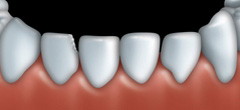
Dental bonding can be used to fix teeth that are chipped.
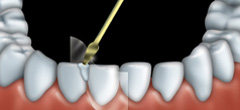
A clear plastic is placed between the tooth being treated and its neighbouring tooth. Composite resin is put on the tooth in layers.
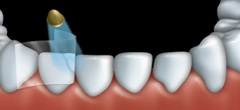
Each layer of the composite resin is shaped and then hardened with a light.
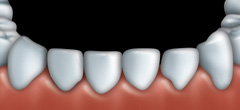
The finished tooth looks natural and smooth.
Veneers – Victoria, BC, Dentists
What are Veneers?
Veneers are very thin shells that are attached to the front part of teeth. They are often made of porcelain or composite resin. Porcelain veneers are stronger than composite resin veneers and do not change colour or stain. Generally, porcelain veneers take at least 2 dental visits to apply and composite resin veneers can be done in 1 visit. Porcelain veneers generally last longer than composite resin veneers.
How Composite Resin Veneers are Done
Much like bonding, your dentist puts a mild chemical on the front surface of the tooth to be veneered to make it a little rough. This helps the composite resin to stick to the enamel of the tooth. The composite resin that matches the colour of your natural teeth is chosen so that the veneer blends in with your teeth. Your dentist then puts the composite resin on your tooth in layers. A bright light is used to harden each layer of the composite resin. After the last layer of composite resin is hardened, your dentist shapes and polishes it to form your tooth. The finished tooth looks natural and smooth.
How Porcelain Veneers are Done
With porcelain veneers, your dentist may give you a local anesthetic (freezing). Your dentist then removes a thin layer of the enamel from your teeth to make room for the veneers. Then your dentist makes a mold of your teeth. This mold is used to custom-make your porcelain veneers. In the meantime, your dentist may place temporary veneers to replace the portion of the tooth that was removed. These are worn until your porcelain veneers are ready. The temporary veneers are very fragile and need to be treated gently during eating and cleaning as they come loose very easily
On your next visit, your dentist removes the temporary veneers and puts a mild chemical on your teeth to make them a little rough. This helps the porcelain veneers stick to your teeth better. The porcelain veneers are then glued to your teeth one by one, using composite resin cement.
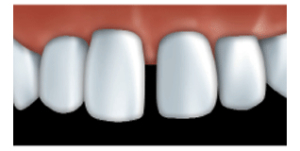
Veneers can be used to fill in gaps.
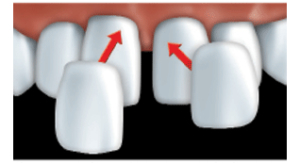
The custom-made porcelain veneers are glued to your teeth one by one with composite resin cement.
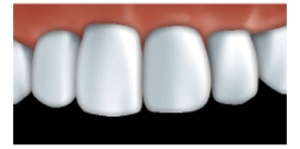
Veneers look very much like natural teeth.
Who Can Get Veneers?
Not everyone is a good candidate for veneers. Here are some reasons why your dentist may suggest treatments other than veneers:
- If a tooth has decay or is in an area that has periodontal disease (gum disease). These problems must be treated first.
- If a tooth has little enamel left, a veneer will not stick to it properly.
- If too much of the tooth is missing, a crown may be another option.
- If a person grinds or clenches his or her teeth. This habit is called bruxism and can chip or break porcelain veneers
What Else Should I Know?
- Just like your natural teeth, your veneered tooth needs to be brushed and flossed daily.
- If the veneers are not fully placed or sealed onto your tooth, stains or cavities can form under the veneer.
- Once you have veneers, you cannot reverse the treatment because part of your enamel has been removed.
- If a veneer chips or peels off, or if a cavity forms under a veneer, the veneer must be redone. The other option is to put a crown on the tooth.
- Constantly grinding or clenching your teeth may cause your bonding or veneers to chip or break.
- Porcelain veneers and bonded teeth can be chipped if you are not careful when biting or tearing into hard or chewy foods. Do not bite hard objects like ice cubes or fingernails.
- Cosmetic dental treatments like bonding or veneers might not be covered by your dental plan. You may be responsible for those costs yourself.
